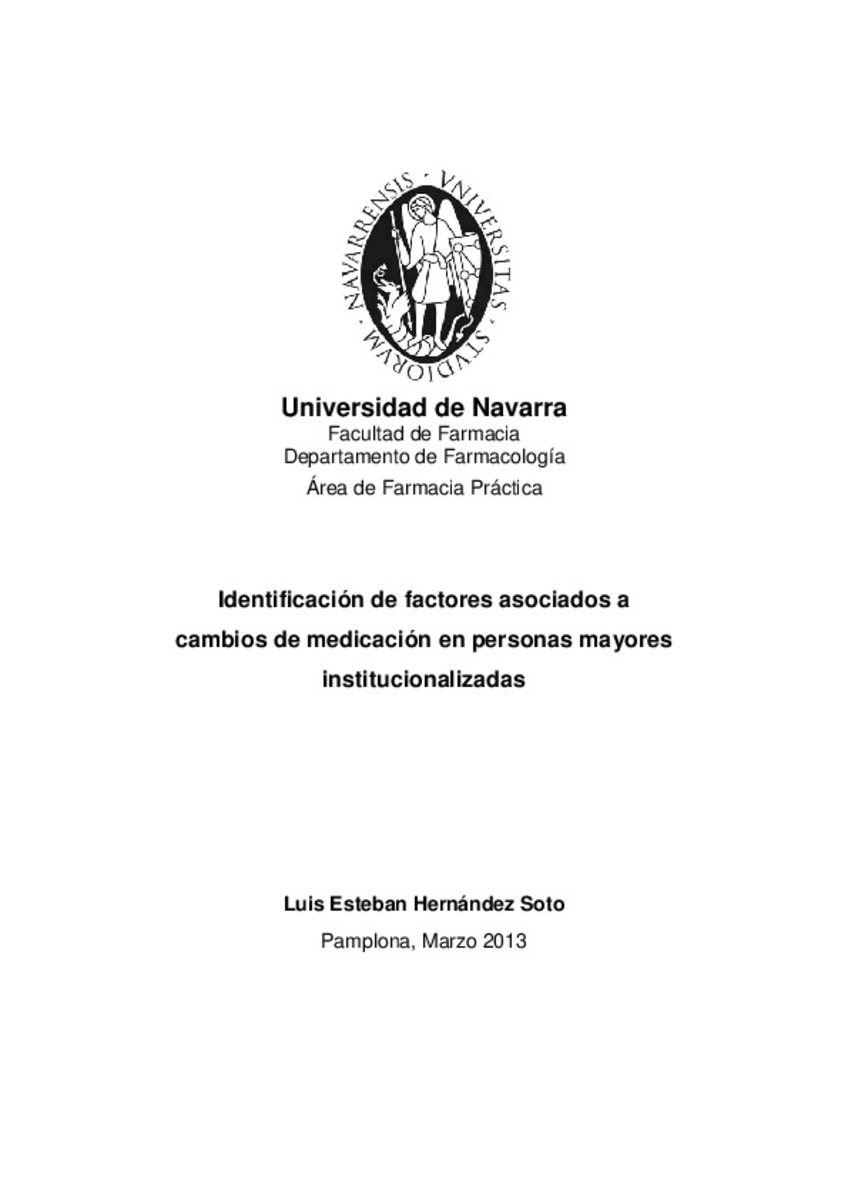Full metadata record
| DC Field | Value | Language |
|---|---|---|
| dc.contributor.advisor | Ruiz-Canela, M. (Miguel) | - |
| dc.contributor.advisor | Lasheras, B. (Berta) | - |
| dc.creator | Hernández-Soto, L. E. (Luis Esteban) | - |
| dc.date.accessioned | 2015-07-24T07:31:29Z | - |
| dc.date.available | 2015-07-24T07:31:29Z | - |
| dc.date.issued | 2015 | - |
| dc.date.submitted | 2013-06-14 | - |
| dc.identifier.citation | HERNÁNDEZ SOTO, Luis Esteban. “Identificación de factores asociados a cambios de medicación en personas mayores institucionalizadas”. Lasheras Aldaz, Berta (dir.), Ruiz-Canela López, Miguel (codir.) Tesis doctoral. Universidad de Navarra, Pamplona, 2013 | es_ES |
| dc.identifier.uri | https://hdl.handle.net/10171/38798 | - |
| dc.description.abstract | Objective: To identify factors associated with the number of medication changes (MC) in elderly nursing home residents. Method: Prospective study for 4 months. The number of MC was recorded weekly. We analyzed the factors associated with having a large number of changes (4 or more), calculating the odds ratio as a measure of association through multivariate logistic regression and a confidence interval of 95% (OR, 95% CI) Results: There were 997 CM in 234 residents. A 80.0% of patients had any medication change, while 42.7% of patients had four or more CM. The largest number of MC was associated with nervous system medicines, digestive and metabolism system medicines and cardiovascular system medicines. Factors associated with a large number of CM were having chronic renal failure, immobility, heart failure, loss of visual acuity, dysphagia, edema, comorbidity and polypharmacy. Both polypharmacy and comorbidity (measured by the Charlson index) were associated with a high number of medication changes (¡Ý 4) in four months, regardless of other variables. The risk of having a large number of medication changes in patients with polypharmacy is three times higher, while in patients with comorbidity is twice as high. On the other hand, patients suffering from the above diseases had approximately twice the risk of having 4 or more medication changes in four months. Conclusions: A large number of CM is associated with risk factors as indicators of drug-related problems. The number of CM in elderly nursing home residents may be an indicator to prioritize the medication review. | es_ES |
| dc.language.iso | spa | es_ES |
| dc.publisher | Servicio de Publicaciones. Universidad de Navarra. | es_ES |
| dc.rights | info:eu-repo/semantics/openAccess | es_ES |
| dc.subject | Changes in medication | es_ES |
| dc.subject | Medicación review | es_ES |
| dc.subject | Drug related problems | es_ES |
| dc.subject | Geriatric pharmacotherapy | es_ES |
| dc.subject | Nursing homes | es_ES |
| dc.subject | Pharmacy services | es_ES |
| dc.subject | Personas mayores | es_ES |
| dc.subject | Cambios de medicación | es_ES |
| dc.subject | Materias Investigacion::Farmacia::Farmacia y farmacología | es_ES |
| dc.title | Identificación de factores asociados a cambios de medicación en personas mayores institucionalizadas | es_ES |
| dc.type | info:eu-repo/semantics/doctoralThesis | es_ES |
Files in This Item:
Statistics and impact
Items in Dadun are protected by copyright, with all rights reserved, unless otherwise indicated.






